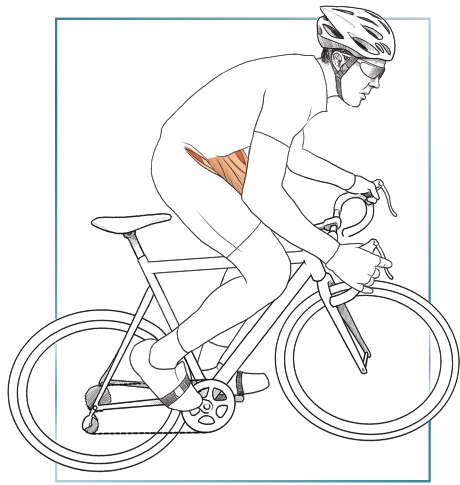CHAPTER 7
Legs: Muscle Isolation
The legs and hips are the fundamental driving force of the cyclist. Like the well-defined muscles of a thoroughbred racehorse, the legs on a cyclist display years of hard training and conditioning. Professional cyclists treat their legs like a valuable commodity. Not only do they focus on developing strength and power in the gym, but they also ensure proper recovery after training. Stretching, compression stockings, massage, and elevation are all utilized to avoid injury and get the most out of their workouts.
Throughout the previous chapters, we’ve discussed the importance of the body’s other musculature to the rider’s performance. But no muscle group is as important to the cyclist as the lower extremities. With all the other muscles of the body playing the role of supporting cast, the legs are unquestionably the stars of the show. The rider’s entire body revolves around the primary purpose of delivering optimal power to the cranks. The exercises in this chapter will guide you to greater strength and fitness in your lower extremities—and thus show you the road to improved cycling performance.
Because of the importance of the lower extremities, cyclists sometimes focus all their workout time on this area of the body. However, you must not forget about all the exercises for the muscles discussed in the previous chapters. Remember, the best quarterback would be useless without all the supporting teammates who allow him to do his job. The same can be said for your legs. Without support and a firm foundation, your legs will never be able to perform at their maximum potential.
Skeletal Anatomy
The three major joints of the lower body are the hip, knee, and ankle. The hip is a ball-and-socket joint that articulates (connects) the proximal end of the femur to the pelvis. The top part of the femur, known as the femoral head, forms the “ball.” The “socket” is formed by the acetabulum of the pelvis. A ball-and-socket joint allows a wide range of flexibility and movement. Although the hip can move in six different directions, the cyclist primarily uses the two most powerful movements—flexion (moving the knee up during the up pedal stroke) and extension (moving the knee down during the down pedal stroke). The hip can also move in adduction (pulling the leg inward), abduction (moving the leg outward to the side), internal rotation (turning the foot inward), and external rotation (turning the foot outward).
The knee joint is formed by three bones: the femur (positioned superiorly), the tibia (positioned inferiorly), and the patella (kneecap). As a hinge joint, the knee’s range of motion is more limited than the hip’s. It moves in only one plane, performing flexion (bending the knee) and extension (straightening the knee). Multiple ligaments stabilize the knee joint under force. These ligaments include the medial collateral ligament (MCL), lateral collateral ligament (LCL), anterior cruciate ligament (ACL), and posterior cruciate ligament (PCL).
The ankle also works as a hinged joint, but it is much more complicated than the knee. Actually, two different joints are often collectively referred to as the “ankle.” The true ankle joint is composed of the tibia, fibula, and talus. The combined position of the tibia and fibula forms a snug cap that rests on top of the rectangular surface of the talus. This joint moves in the vertical plane, in both dorsiflexion (foot up) and plantar flexion (foot down). The calcaneotalar joint is the second of the two joints; as the name implies, this joint is composed of the calcaneus and talus. This joint enables the foot to move in inversion (rolling the foot inward) and eversion (rolling the foot outward). Multiple ligaments, including the lateral ligament complex and the medial deltoid ligament, stabilize the entire ankle and the calcaneotalor joint, making them extremely tough and stable.
Quadriceps
The quadriceps muscle performs extension of the knee and becomes highly developed and powerful in most cyclists. Four different muscle bellies make up the quadriceps muscle:
1. Rectus femoris
2. Vastus intermedius
3. Vastus medialis
4. Vastus lateralis
These muscle bellies all come together as they cross over the knee to form a fibrous band that engulfs the patella. This fibrous band is known as the patellar tendon, and its insertion is on the anterior (front) of the proximal end of the tibia. The rectus femoris originates on the iliac spine of the pelvis. The vastus lateralis, vastus intermedius, and vastus medialis originate on the lateral, anterior, and medial surfaces of the upper femur. See figure 7.1 for an illustration of these muscles.
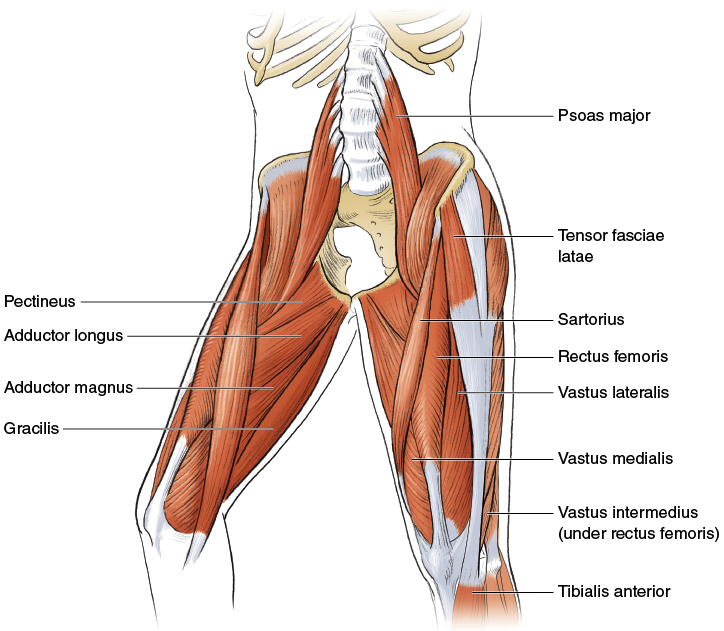
Figure 7.1 Muscles of the front of the leg.
Hamstrings
The hamstring is the large posterior (back) muscle group of the upper leg (see figure 7.2). This muscle group acts as the primary flexor of the knee. The hamstring group is formed by three muscles:

1. Biceps femoris
2. Semimembranosus
3. Semitendinosus
The hamstring originates on the ischial tuberosity of the pelvis and the posterior aspect of the femur. The muscle tracts down the back of the femur and inserts on the lateral and medial condyles of the tibia as well as on the fibular head. Because the hamstring spans both the hip and knee joint, it has a dual action. The hamstring performs knee flexion and also acts as a hip extender. Similar to the quadriceps, the hamstring becomes a powerful muscle in the well-developed cyclist.
Figure 7.2 Muscles of the back of the leg.
Gluteals
The gluteus maximus is the largest and most apparent gluteal muscle (see figure 7.2). This muscle is the primary hip extensor, and it gives the cyclist serious downward power during the pedal cycle. The gluteus maximus originates on the ilium and sacrum of the pelvis. It runs medial to lateral (inside to out) and inserts on the femur. Along with the tensor fasciae latae, the gluteus maximus contributes to the iliotibial (IT) band. This thick fibrous sheath travels down the lateral part of the thigh to insert on the lateral condyle of the tibia. The IT band is often the cause of discomfort after hard training days.
The two other gluteal muscles—the gluteus minimus and gluteus medius—act as rotational and lateral movers of the leg. The gluteus minimus abducts and internally rotates the thigh. This muscle lies underneath the gluteus maximus and connects the pelvis to the greater trochanter of the femur. The gluteus medius also abducts the thigh. Depending on the degree of abduction, the gluteus medius can either internally or externally rotate the leg.
Other Upper Leg Muscles
Numerous other muscles help the hip move in both adduction (toward the centerline) and abduction (away from the centerline):
Hip adductors: Gracilis, adductor brevis, adductor longus, adductor magnus, pectineus
Hip abductors: Gluteus medius, gluteus minimus, tensor fasciae latae, sartorius
The hip flexors are not nearly as powerful as the gluteus maximus discussed above. However, as mentioned elsewhere in this book, the goal of an efficient cyclist is to have a smooth, constant pedal stroke. Therefore, cyclists should train not only the hip extenders, but also the following group of hip flexors:
Hip flexors: Sartorius, iliopsoas, rectus femoris, tensor fasciae latae, pectineus, adductor brevis, adductor longus
Lower Leg Musculature
The posterior muscles of the lower leg are also very important to the cyclist. The three muscle bellies of the calf—medial gastrocnemius, lateral gastrocnemius, and soleus—are collectively called the triceps surae (see figure 7.2 on page 125). All of these muscles help the cyclist perform plantar flexion, which is an important part of the pedaling motion. The gastrocnemius originates on the medial and lateral condyle of the femur and inserts on the calcaneus (heel bone) via the Achilles tendon. Because it crosses the knee joint, it also aids the hamstring in knee flexion. The soleus originates on both the tibia and fibula. Along with the gastrocnemius, the soleus inserts onto the calcaneus by way of the Achilles tendon.
The anterior (front) compartment of the lower leg houses numerous muscles that perform dorsiflexion (upward foot and toe movement). The tibialis anterior is the medial (middle) muscle, and it extends from the lateral condyle of the tibia to the first metatarsal and first cuneiform bone of the foot. During the pedal stroke, you’ll activate this muscle to pull your foot upward. Other muscles in this area include the extensor hallucis longus (dorsiflexion of the great toe), the extensor digitorum longus (dorsiflexion of the toes), and the peroneus tertius (dorsiflexion and eversion of the foot). The peroneus longus and brevis are found in the lateral compartment of the lower leg and primarily act to evert the ankle.
The exercises in this chapter will help you isolate the various leg muscles that you’ll use while riding. By focusing your training on specific muscles, you’ll be able to strengthen the foundation on which you build your riding power. The next two chapters will provide exercises for working multiple muscle groups at the same time. During these combination exercises, your body can sometimes “cheat” and use stronger muscles to support and help weaker muscles. That’s why isolation exercises are so crucial to your training.
Warm-Up and Stretching
The legs contain large muscle groups, so you must adequately warm up extensive muscle tissue before doing a leg workout. Spend 10 minutes riding the stationary bike before stretching. You need to stretch each major muscle group. You should perform exercises that specifically stretch the quadriceps, hamstrings, gluteals, and calves before any resistance training. This may seem a bit tedious and time consuming, but it is very important for helping you avoid injury.
Leg Extension


Safety Tip
To avoid lower back injury, keep your spine flat against the machine pad.
Execution
1. Sit on the machine with the middle of your knee aligned with the pivot point.
2. Raise your legs until your knees are straight. Your toes should be pointed upward.
3. After a brief pause, return to the starting position (knees bent to 90 degrees).
Muscles Involved
Primary: Quadriceps
Secondary: None
Cycling Focus
The next time you go out on a ride, try to feel your various leg muscles firing while you are pedaling at a steady rate. Try to do the same during a fierce acceleration in a sprint or a climb. You’ll note that as your leg kicks over the top of the pedal stroke, your quadriceps will fire with a vengeance. You’ll also be able to feel the similarity between this part of your pedaling motion and the motion used on the leg extension machine. This exercise (like the others in this chapter) isolates one of your major cycling muscles. Look at the development of any serious rider’s quads, and you’ll realize just how much these muscles are used during riding.

Seated Leg Curl

Execution
1. Sit on the machine with the middle of your knee aligned with the pivot point.
2. Keeping your back flat, flex at the knees until they are bent to 90 degrees. Keep your toes pointed upward.
3. After a brief pause, return to the starting position (knees straight).
Muscles Involved
Primary: Hamstrings
Secondary: Gastrocnemius, gracilis, sartorius, popliteus
Cycling Focus
The efficiency of the pedal stroke requires the constantly alternating and combined effort of both your legs. As one leg is emphasizing pulling, the other is emphasizing pushing. Just as the leg extension exercise replicates the top and front part of your pedal stroke, the leg curl focuses on the bottom and back part of your pedaling motion. As you sit on the leg curl machine, imagine pulling your foot through the bottom arc of your pedal stroke. Feel the similarity between the exercise motion and the upward pull you perform when completing a revolution of the crank. Be sure you don’t “cheat” on this exercise by arching your back and angling your hips. Remember, the purpose is to isolate the hamstrings and give them the best training possible.

Variation
Lying Leg Curl
The lying leg curl also incorporates a slight hip extension when maximally contracting your hamstrings.

Stiff-Leg Deadlift
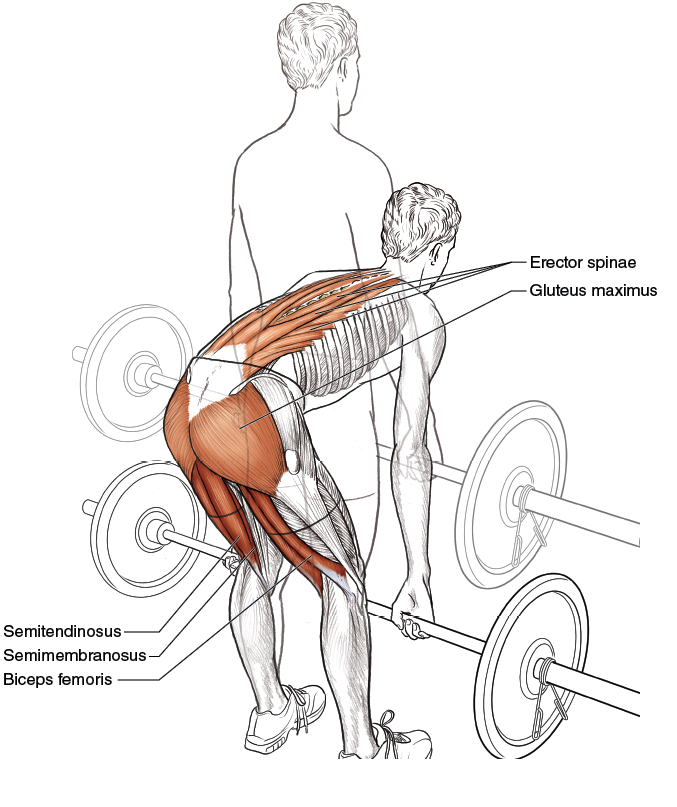

Safety Tip
Make certain to keep your head up. This will help keep your spine straight and prevent low back injury.
Execution
1. Stand with your feet shoulder-width apart. Hold the bar using a shoulder-width, palm-down grip. Your arms should be straight.
2. Bend forward at the waist, keeping your back and legs straight.
3. After nearly touching the floor with the weights, return to the starting (upright) position.
Muscles Involved
Primary: Hamstrings
Secondary: Erector spinae, gluteus maximus
Cycling Focus
The stiff-leg deadlift focuses on the entire back side of the rider’s physique. During the exercise, you can really feel how this replicates the movement of your legs when you’re bent forward in your handlebar drops or aero bars. If you focus on your back, hips, and thighs while riding—and then recall the sensation while performing the stiff-leg deadlift—you’ll see the benefit of working this exercise in the gym. A large portion of your power on the bike, whether you are sitting or standing, comes from the extension of your leg at the hip. When you focus on this area in your workout, you will definitely reap the benefits in your power and performance.

Variation
Dumbbell stiff-leg deadlift: If you have a difficult time managing the bar, you can perform the exercise using dumbbells. Follow the same form as described for the stiff-leg deadlift.
Standing Calf Raise

Execution
1. Place your toes on the platform, and place your shoulders snugly under the pads.
2. Keeping your back and knees straight, lower your heels until you feel a good stretch in your calves.
3. Slowly raise your body by raising your heels to the tiptoe position.
4. Return to the starting (heel down) position.
Muscles Involved
Primary: Gastrocnemius
Secondary: Soleus
Cycling Focus
The calf is a highly developed muscle on any serious cyclist. As your leg moves through the pedaling motion, your gastrocnemius and soleus will add to the power of each rotation. To maintain efficiency, the angle of your foot in relation to the ground should not be changing drastically during the rotation of the pedals. Since the crank is constantly moving, your ankle must act as a buffer to keep your foot in its relatively stable position. The gastrocnemius and soleus play a big part in this movement at the ankle. Whenever you move your leg downward through the pedaling stroke, your gastrocnemius and soleus will contribute to the downward force transferred to the pedal—and subsequently to the forward progress of the bike. When I was racing, I used to study the pedal rotation and foot position of Andy Hampsten. His efficient pedaling motion is a perfect example of proper foot position and ankle movement.

Seated Reverse Calf Press

Execution
1. Place your feet high on the platform of the leg press.
2. Keeping your knees straight, pull the tops of your feet back toward your body while pushing the platform with your heels.
3. Return to the starting position (feet fully resting on the platform).
Muscles Involved
Primary: Tibialis anterior
Secondary: Extensor digitorum longus, peroneus longus
Cycling Focus
Efficiency is a key component to being a successful cyclist. Ideally, any effort or movement of the rider should make the bike move forward faster. Unfortunately, a good portion of a cyclist’s effort is often lost in translation, whether it’s because of wind resistance, heat dissipation, equipment issues, or other factors. So every little bit of power generation and efficient movement helps. As previously mentioned, the foot should remain relatively still during the pedaling motion. Like the gastrocnemius and soleus, the anterior muscles of the lower leg also contribute to this stability. These anterior muscles also help drive the pedal upward during the back half of the pedal stroke. The seated reverse calf press will help isolate these muscles and specifically prepare them to do their part during your pedal stroke.

Variation
Standing Reverse Calf Raise
You can work the anterior muscles of the lower leg using various machines. If you’d prefer not to switch, you can work these muscles on the same machine used in the calf raise. Turn around and face outward, placing your heels on the platform. Lift your toes upward, completing the same motion as described for the seated reverse calf press.

Machine Adduction
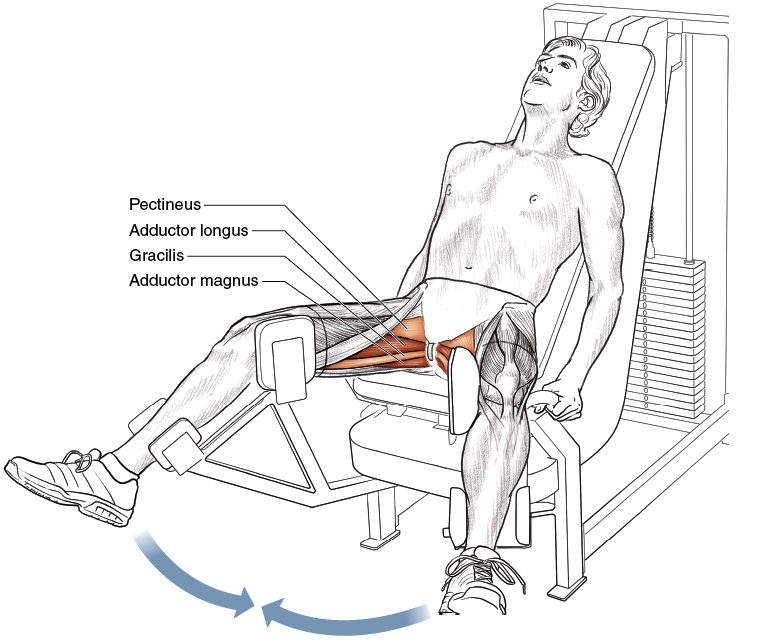
Execution
1. Sit on the adduction machine with your legs spread.
2. Slowly bring your legs together until the leg pads touch.
3. With controlled movement, bring your legs back to the starting position.
Muscles Involved
Primary: Adductor magnus, adductor longus
Secondary: Gracilis, pectineus, lower gluteus maximus
Cycling Focus
Although you won’t actually move your legs in adduction during your pedaling motion, you still need to strengthen the adductor muscles. During hard efforts, you’ll want to maintain a clean, streamlined rotational motion of your legs. Your adductors will help support the primary movers of the cranks. By conditioning your adductors, you can decrease the likelihood of your form breaking down when you are fatigued. If you watch a professional’s pedaling motion—even at the end of the race when the rider is tired—you’ll notice how smoothly the legs rotate. This comes from years of training and from having well-conditioned accessory muscles that help keep the legs properly aligned.
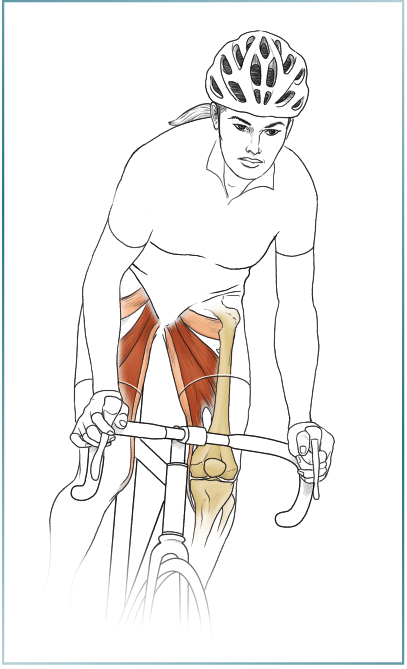
Variation
Cable Hip Adduction
A cable-pulley system offers a great alternative for working your hip adductors. This system allows good range of motion and effectively isolates the hip adductors.
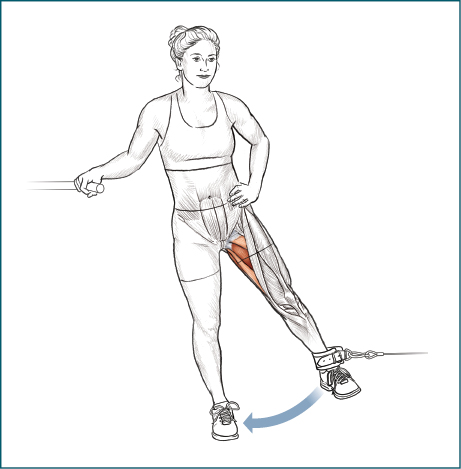
Machine Abduction

Execution
1. Sit on the abduction machine with your legs together.
2. Slowly spread your legs apart as far as possible. Keep your back flat against the pad.
3. With controlled movement, bring your legs back to the starting position.
Muscles Involved
Primary: Gluteus medius, gluteus minimus
Secondary: Gluteus maximus, piriformis, obturator externus, tensor fasciae latae
Cycling Focus
Similar to the hip adductors, the hip abductors play a key role in stabilizing your pedaling motion. Strong stabilizers will be especially helpful when you are riding with high fatigue levels—such as at the end of a race. The hip abductors are prone to spasm and cramping when you’re fatigued and at the limit of your fitness. By training these muscles in the gym, you’ll increase the strength of the muscle as well as the blood flow and vascular beds that course throughout the muscle. This will help prevent cramping and spasm, and it will prolong the time it takes for you to reach fatigue.
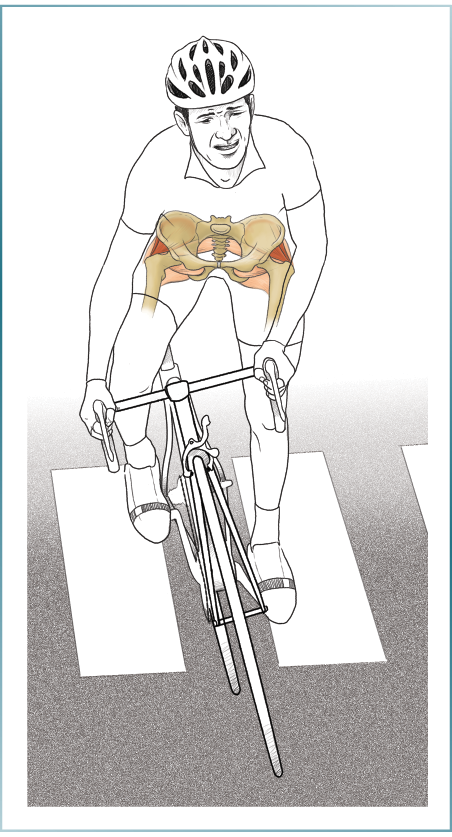
Variation
Fire hydrant: If you do not have access to a hip abduction machine, you can work your hip abductors using a cable-pulley system (as described in the variation of the hip adductor exercise). You can also work these muscles on the floor. The fire hydrant is a simple exercise that can be done anywhere. Position yourself on your hands and knees. Lift one leg up and out to the side, keeping your knee bent. Be sure to focus on your hip motion while lifting your leg.
Cable Back Kick

Execution
1. Attach a low pulley to your ankle. Face the pulley system and grasp the handles.
2. Keeping your leg straight, extend at the hip, moving your foot backward.
3. Slowly return to the starting position. Complete the set and then switch sides.
Muscles Involved
Primary: Gluteus maximus
Secondary: Hamstrings
Cycling Focus
The gluteus maximus plays a huge role when you are driving the cranks on your bike. This muscle provides a large percentage of your power stroke. As you rotate over the top of your pedaling motion and start pushing down, your gluteus maximus fires to move your hip into extension. The development of this muscle is clearly visible when you look at serious cyclists. The cable back kick is fundamental to cycling training because it is the best exercise for isolating this key muscle. To save time during your workout, you can work hip adduction, hip abduction, hip extension, and hip flexion all on one side before switching the attachment to the other leg.
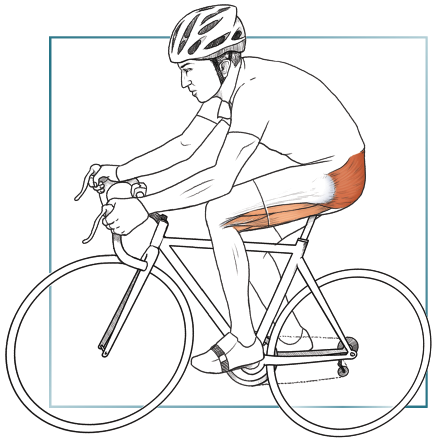
Variation
Stability Ball Hip Extension
This is a great hip extension exercise. Lie with your back flat on the floor. One leg should point upward, and the other heel should be resting on top of the stability ball. Push down on your heel and raise your hips toward the ceiling. Slowly return to the starting position.

Single-Leg Cable Raise
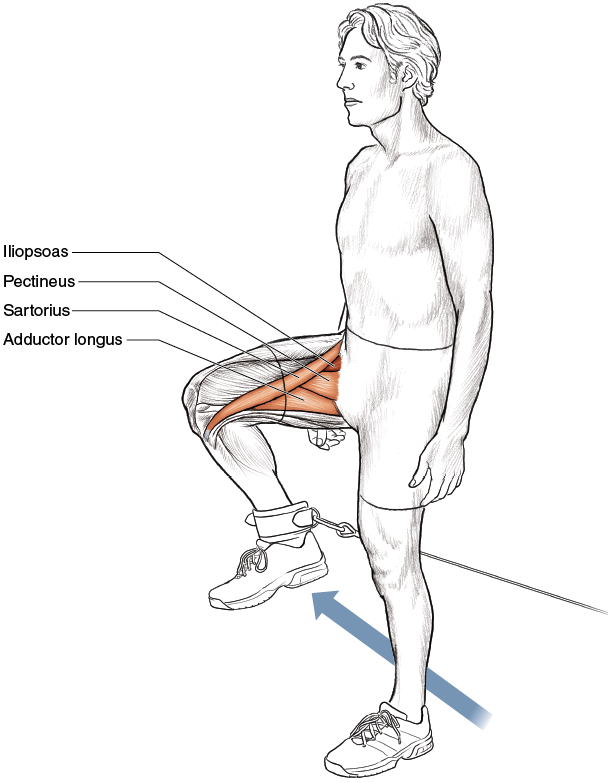
Execution
1. Face away from a low pulley attached to one of your ankles. Grasp the bars for stability if necessary. Your attached leg should be in slight hip extension.
2. Pull your knee upward against the pulley resistance, bending at the hip.
3. When your thigh is parallel with the floor, slowly lower your leg back to the starting position.
Muscles Involved
Primary: Iliopsoas
Secondary: Pectineus, sartorius, adductor longus, adductor brevis
Cycling Focus
The single-leg cable raise mimics the upward drive of your leg as you rotate the cranks on your bike. Imagine surging on a climb or jumping for the line when closing on the finish. Many people talk about “pedaling in circles.” They mean that you should concentrate on applying power to the pedals throughout the entire rotation of the crank. This is a good way to think about the pedaling motion, but in reality, riders pedal in more of a triangle pattern: up, down, and across the bottom. Whichever way you choose to think about it, you should make sure that both legs continually contribute to speeding your bike forward. The single-leg cable raise will isolate the upward movement of the pedaling stroke and help train your entire pedaling “circle.”
